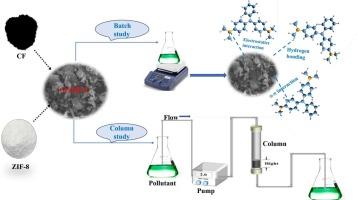碳水化合物衍生泡沫碳/ZIF-8复合材料去除孔雀石绿的超高吸附性能:机理及实际应用
IF 4.6
3区 材料科学
Q2 MATERIALS SCIENCE, MULTIDISCIPLINARY
引用次数: 0
摘要
在这项研究中,我们开发了一种沸石咪唑酸框架-8 (ZIF-8)与碳水化合物衍生泡沫碳(CF)作为吸附剂的复合材料,用于有效去除孔孔石绿(MG)染料和真实纺织废水。该复合材料是通过可持续的途径合成的:用琼脂粉在低温(180℃)下生产CF。批量吸附实验表明,在吸附剂浓度为400 mg L-1 mg、吸附剂用量为0.125 g L-1时,吸附剂的最大吸附量为3132 mg g -1。动力学研究表明,该过程遵循伪二阶模型(R2 > 0.999),表明化学吸附驱动摄取,而平衡数据最符合Sips等温线(R2 = 0.966),强调非均质表面相互作用。在固定床柱研究中,CF/ZIF-8复合材料在优化条件下(1 cm床高,0.5 mL min - 1流速)对实际纺织废水的去除率达到50%。突破曲线与Thomas模型一致,证明了实际的可扩展性。三个循环的可重用性测试保持了96%的效率,强调了复合材料的稳定性。该复合材料的超高吸附能力高于许多报道的材料,再加上其低成本、节能的合成,使其成为真正的纺织废水处理的有前途的解决方案。本文章由计算机程序翻译,如有差异,请以英文原文为准。

Ultrahigh adsorption capacity of carbohydrate-derived carbon foam/ZIF-8 composite for malachite green removal: mechanistic Insights and practical applications
In this study, we developed a composite of zeolitic imidazolate framework-8 (ZIF-8) with carbohydrate-derived carbon foam (CF) as an adsorbent for efficient removal of malachite green (MG) dye and real textile wastewater. The composite was synthesized through a sustainable route: CF was produced at low temperatures (180 °C) using agar powder. Batch adsorption experiments demonstrated an exceptional maximum adsorption capacity of 3132 mg g−1 at 400 mg L-1 MG concentration and 0.125 g L-1 adsorbent dosage. Kinetic studies revealed that the process followed the pseudo-second-order model (R2 > 0.999), indicating chemisorption-driven uptake, while equilibrium data best fitted the Sips isotherm (R2 = 0.966), highlighting heterogeneous surface interactions. In fixed-bed column studies, the CF/ZIF-8 composite achieved > 50 % removal efficiency for real textile effluent under optimized conditions (1 cm bed height, 0.5 mL min−1 flow rate). The breakthrough curves aligned with the Thomas model, demonstrating practical scalability. Reusability tests over three cycles retained > 96 % efficiency, underscoring the composite’s stability. The composite’s ultrahigh adsorption capacity is higher than many reported materials coupled with its low-cost, energy-efficient synthesis, positioning it as a promising solution for real textile wastewater treatment.
求助全文
通过发布文献求助,成功后即可免费获取论文全文。
去求助
来源期刊

Materials Science and Engineering: B
工程技术-材料科学:综合
CiteScore
5.60
自引率
2.80%
发文量
481
审稿时长
3.5 months
期刊介绍:
The journal provides an international medium for the publication of theoretical and experimental studies and reviews related to the electronic, electrochemical, ionic, magnetic, optical, and biosensing properties of solid state materials in bulk, thin film and particulate forms. Papers dealing with synthesis, processing, characterization, structure, physical properties and computational aspects of nano-crystalline, crystalline, amorphous and glassy forms of ceramics, semiconductors, layered insertion compounds, low-dimensional compounds and systems, fast-ion conductors, polymers and dielectrics are viewed as suitable for publication. Articles focused on nano-structured aspects of these advanced solid-state materials will also be considered suitable.
 求助内容:
求助内容: 应助结果提醒方式:
应助结果提醒方式:


